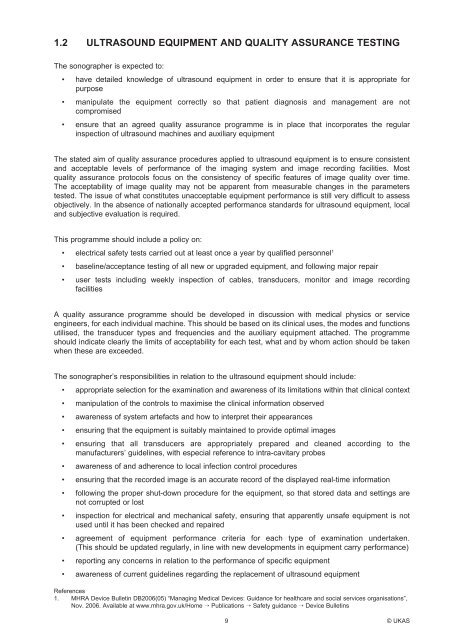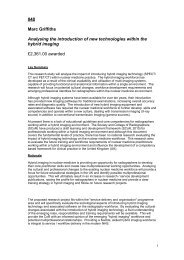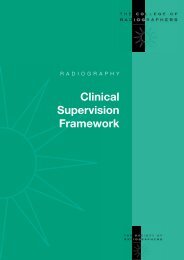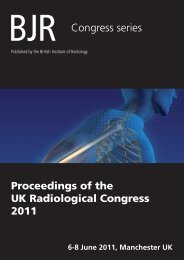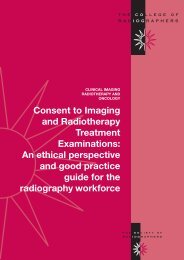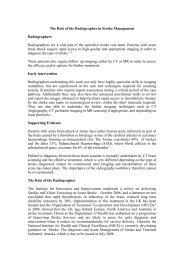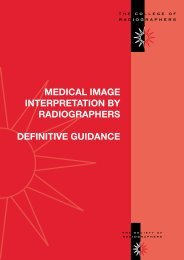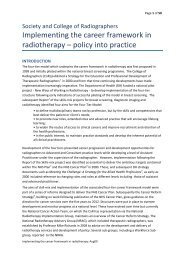Guidelines For Professional Working Standards Ultrasound Practice
Guidelines For Professional Working Standards Ultrasound Practice
Guidelines For Professional Working Standards Ultrasound Practice
Create successful ePaper yourself
Turn your PDF publications into a flip-book with our unique Google optimized e-Paper software.
1.2 <strong>Ultrasound</strong> Equipment And Quality Assurance Testing<br />
The sonographer is expected to:<br />
• have detailed knowledge of ultrasound equipment in order to ensure that it is appropriate for<br />
purpose<br />
• manipulate the equipment correctly so that patient diagnosis and management are not<br />
compromised<br />
• ensure that an agreed quality assurance programme is in place that incorporates the regular<br />
inspection of ultrasound machines and auxiliary equipment<br />
The stated aim of quality assurance procedures applied to ultrasound equipment is to ensure consistent<br />
and acceptable levels of performance of the imaging system and image recording facilities. Most<br />
quality assurance protocols focus on the consistency of specific features of image quality over time.<br />
The acceptability of image quality may not be apparent from measurable changes in the parameters<br />
tested. The issue of what constitutes unacceptable equipment performance is still very difficult to assess<br />
objectively. In the absence of nationally accepted performance standards for ultrasound equipment, local<br />
and subjective evaluation is required.<br />
This programme should include a policy on:<br />
1<br />
• electrical safety tests carried out at least once a year by qualified personnel<br />
• baseline/acceptance testing of all new or upgraded equipment, and following major repair<br />
• user tests including weekly inspection of cables, transducers, monitor and image recording<br />
facilities<br />
A quality assurance programme should be developed in discussion with medical physics or service<br />
engineers, for each individual machine. This should be based on its clinical uses, the modes and functions<br />
utilised, the transducer types and frequencies and the auxiliary equipment attached. The programme<br />
should indicate clearly the limits of acceptability for each test, what and by whom action should be taken<br />
when these are exceeded.<br />
The sonographer’s responsibilities in relation to the ultrasound equipment should include:<br />
• appropriate selection for the examination and awareness of its limitations within that clinical context<br />
• manipulation of the controls to maximise the clinical information observed<br />
• awareness of system artefacts and how to interpret their appearances<br />
• ensuring that the equipment is suitably maintained to provide optimal images<br />
• ensuring that all transducers are appropriately prepared and cleaned according to the<br />
manufacturers’ guidelines, with especial reference to intra-cavitary probes<br />
• awareness of and adherence to local infection control procedures<br />
• ensuring that the recorded image is an accurate record of the displayed real-time information<br />
• following the proper shut-down procedure for the equipment, so that stored data and settings are<br />
not corrupted or lost<br />
• inspection for electrical and mechanical safety, ensuring that apparently unsafe equipment is not<br />
used until it has been checked and repaired<br />
• agreement of equipment performance criteria for each type of examination undertaken.<br />
(This should be updated regularly, in line with new developments in equipment carry performance)<br />
• reporting any concerns in relation to the performance of specific equipment<br />
• awareness of current guidelines regarding the replacement of ultrasound equipment<br />
References<br />
1. MHRA Device Bulletin DB2006(05) “Managing Medical Devices: Guidance for healthcare and social services organisations”,<br />
Nov. 2006. Available at www.mhra.gov.uk/Home → Publications → Safety guidance → Device Bulletins<br />
9 © UKAS


